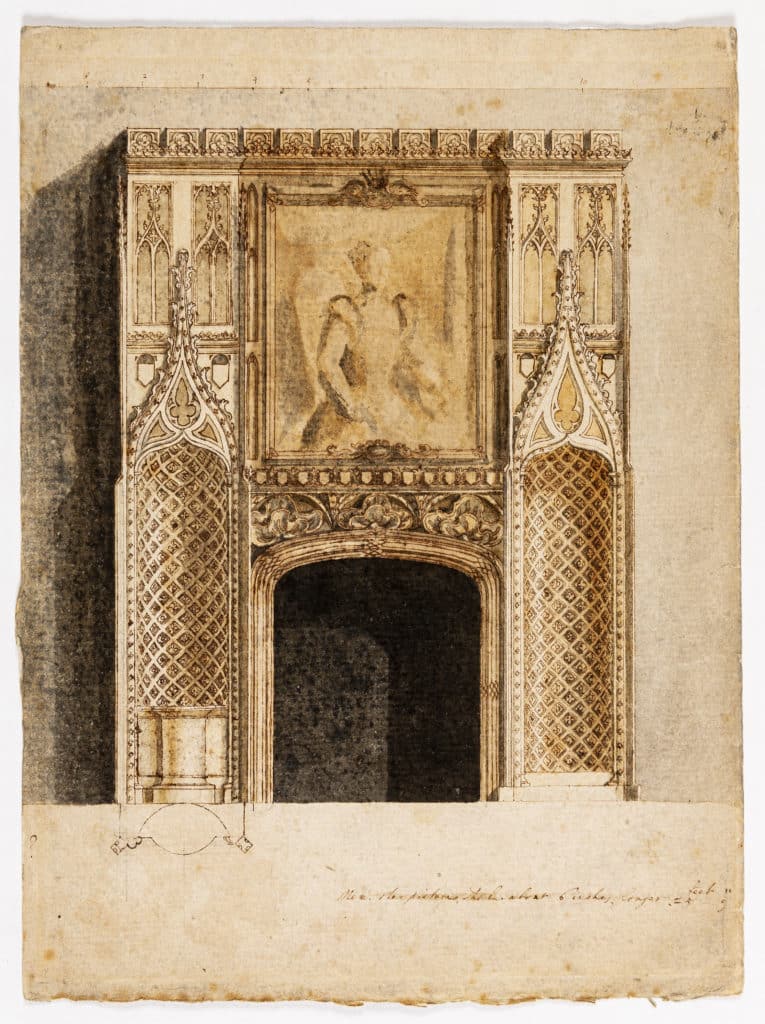Behind the Lines 6

Richard Bentley cracked open the red seal, smiling as he always did at the peculiar crest of a man in a ridiculous long-tasselled hat, and folded out the letter. His mood was anxious; he scratched his head nervously with one hand and knocked over the ink on his drawing table with the other, splashing his waistcoat. He wiped it with his sleeve.
Bentley rapidly scanned the familiar hand, written from Arlington Street he noticed, and dated 19 December, 1753. He quickly skipped through the politesse: ‘your letters grow more and more entertaining…’ He let out an exasperated groan on reading that his designs for the library ‘cannot have the Strawberry imprimatur’. That old finger-twirler John Chute butts to the fore as soon as I am out of the way, he thought to himself. So much for the Strawberry Committee. But here was something positive:
‘…For the chimney, I do not wonder you missed our instructions; we could not contrive to understand them ourselves; and therefore, determining nothing but to have the old picture stuck in a thicket of pinnacles, we left it you to find out the how. I believe it will be a little difficult; but as I suppose facere quia impossibile est, is full as easy as credere, why — you must do it.’ [1]
Something to get his teeth into at last. Finding himself stuck in Jersey avoiding creditors was a dull business. Yesterday, out of boredom, he had resorted to drawing a view of Mount Orgueil, in the vague hope that some island gentleman would buy it. And where in heaven’s name were his wife and children? He was missing the cacophony of family life in Teddington. He was all of a muddle — and at that precise moment hungry, too. He suspected Walpole was not telling her where he was. Damn him; he knew that she was disliked by all the habitués of Strawberry Hill. He had overheard Walpole refer to her as Hecate. [2] Hurtful. He remembered he had been standing in the hall admiring the gloomy light through the painted glass on the lanthorn that he had designed, [3] when he heard Walpole outside, talking in his high penetrating voice to George Montagu, who as usual was screaming and whooping. Out came the painful remark — and then a sudden guilty silence as they noticed his presence.
Thinking about Montagu, reminded him of how he missed the amusements of the place; how last August he and Walpole had fished goldfish out of the pond with a basin and a tea-strainer, and how he had carried a dozen of them up to town in a decanter for Montagu’s pond. And how Walpole had told the neighbours it was how the Chinese fished. [4] A train of thought that led him to regret that his patron now dismissed building in the Chinese style as ‘the fashion of the instant’; he personally enjoyed it.
Musings finished, Bentley returned to the work at hand, strictly Gothic. He could not remember, after the disruptions of the last month, exactly which ‘old picture’ Walpole intended to incorporate into the chimneypiece. He thought it was a Tudor portrait. That could be sorted out at a later date, together with the measurements, but now the pinnacle thicket must be planned. He envisioned some fine ogee curves and lush crockets, a niche either side with a background of delicate tracery — more crockets there… a fine tudor arch over the fireplace — he was sure now the painting was Tudor, so he would suggest a ruffed female portrait in the drawing. He played with the idea of enclosing the painting in a larger cusped arch, but then on impulse decided to finish the upper part of the design with a good bit of brattishing composed of trefoils. Walpole was always partial to shrines and tombs. He vaguely remembered a long screed from Walpole a couple of summer’s ago describing a journey all over Kent and Sussex with Chute: tombs featuring largely — one at Hurstmonceux church ‘all in our trefoil taste, varied into a thousand little canopies and patterns’. [5]
Richard Bentley scrabbled among assorted implements, picked out his current favourite nib and dipped it in what was left of his bottle of sepia ink.
- W. S. Lewis, ed., The Yale Edition of Horace Walpole’s Correspondence, vol. 35, p. 157.
- Ibid. vol. 9, p. 158.
- Ibid. vol. 9, p. 150.
- Ibid. vol. 9, p. 155.
- Ibid. vol. 35, p. 139.

– Niall Hobhouse and Nicholas Olsberg